First, allow me to digress to our flights between Birmingham, UK and Palma de Mallorca, Spain. Mallorca is such a popular destination for Brits (and Germans) that there were numerous non-stop flight options. However, the most convenient (and least expensive) were on the "budget" airlines. From a group of airlines we never heard of, we settled on Monarch Airlines. Of course, the price you see is not necessarily the price you get. That is because EVERYTHING costs extra! Wanna reserve a seat--extra; wanna have enough room in a row of seats to maneuver past the aisle and middle seats into the window seat--extra; wanna check in online--extra; wanna take more than 10kg onto the plane without having to wear it--extra;
wanna drink anything other than tap water--extra. Use of the lavatory is free, IF you can actually reach it from your seat! And, of course, most of these extra charges cost more if you choose them at the airport. Therefore, lest we would end up with more than 10kg each for carry-on, which includes handbags, gym bags, and backpacks, as well as suitcases, we pre-paid for one checked bag. We then had a choice of how many extra kilograms we wanted to check--20kg was one price, 23kg was more, with each additional increment increasing the price.
Airport check-in at Birmingham began three hours before flight time. Mercifully, check-in at the airport in Palma began only two hours before. The line got dreadfully long, but moved relatively quickly, and we still managed to get the aisle (for me) and window (for Henry) seats we prefer. It was humorous, however, that the airline counter rep in Birmingham could not understand at first that to get our desired seat preferences, we were willing to sit separately from each other for the two-and-a-half-hour flight. Ever so careful with our pre-trip packing because of our 20kg checked bag and 10kg each carry-on allowance, we ended up way below our allotted limits. Indeed, had we tried just a little bit harder, we could have skipped the checked bag altogether. Hmmm, NOT! From my perspective, that meant I had more room for purchases of Mallorcan products and gifts!
I do wonder about some of Monarch's policies. When checking in, the airline weighs all checked and carry-on items, but not the individual traveler. This means that if an item is overweight, one solution is simply to stuff things into one's pockets and/or add a few more layers of clothing. We watched some folks actually doing this! The way I figure it, the total weight on board remains the same! Indeed, we overheard someone say that a Samoan airline is now charging folks according to their body weight, so that the sumo wrestler pays more than the frail old woman! Another quirk: After weighing carry-on bags, Monarch places a colored tag on each of these bags. We subsequently discovered that the colors are coded to designate where the bag can be placed once on the plane--i.e., overhead or under the seat in front. Unfortunately, there is absolutely no consistency in this process. Going to Palma, our respective backpacks received overhead storage tags; on the return flight, they received under the seat tags, and I almost was stuck having to remove my backpack from the overhead bin. There is something wrong with this picture. Why should someone be penalized for paying to check a bag he/she could otherwise have put in the overhead bin, only to be told that he/she would be required to reduce already minimal foot space even further by having to place his/her single carry-on item under the seat in front of him/her? At the end of the day, so to speak, we arrived safely at our desired destinations. Monarch flies real airplanes, with real crews, and our checked bag arrived with us, at both ends of the trip. We were still happy campers.
Even though I did not have the excuse of wrong side of the street driving to convince Henry he should be the designated driver on Mallorca, I knew that narrow, windy roads were still more at his driver comfort level than mine. I was content to be the navigator, which got a bit more difficult after our GPS (brought from home) died two days into the trip. Fortunately, with an analog map in hand and relatively good and frequent signage, I was able to steer us (or did Henry do the steering, while I did the direction pointing?) to our intended destinations. While the GPS was working, we were able to enjoy the electronic voice's bastardization of the some of the Catalan/Spanish street names, especially the ones with double "ll" in the names, e.g., Lluc, Soller. We also found ourselves back in the United States, figuratively (or electronically) at least, when the voice referred to route MA2020 at "Massachusetts 2020"!
We stayed four nights at a small hotel in the quiet town of Selva, about forty minutes from Palma. It turned out the hotelier was an ex-pat Brit, now married to a Mallorcan woman. This eliminated any communication issues, and it enabled us to understand suggestions on the best spots to visit. Each morning, we had breakfast on the patio.
In the evenings, we ate outside at their restaurant just off the town square.
and from the window in our room, we had wonderful views of the surrounding countryside, all the way to the sea.
And, of course, Selva had its narrow roads,
and church in the town square on the hilltop.
The drives through the mountains of Serra de Tramuntana to Lluc, Soller, and Port Soller also came with their share of narrow, windy roads:
but the views were spectacular!
Trying to stay as much as possible away from the major "touristo" spots (in a tourist mecca like Mallorca, it's all relative), we had lunch in Formalutx, just outside of Soller--
still touristed, but not as overwhelmingly as Lluc, Soller, and Port Soller. Plus, the setting,

the views from the restaurant,
the food (calamari a la plancha (photo below), rather than a la romana, which I discovered means breaded and fried, was fresh; and the yummy olives probably came straight from Malloran olive trees, planted on stone-walled terraces similar to those in the above photo),

and, especially the company,
were excellent!
With two lovely walks on the same day, I was quite content. The first was just outside of Lluc, with lots of solitude, greenery, views, and rippling rock formations.
I think the ripples (see above photos) are created from a combination of carbon dioxide and rain acting on the carbonate rock (limestone here), a process called karstification. I'll have to check with Henry on that one! One thing I don't need to check on with my scientist husband is the high quality and attractiveness of the trash receptacles scattered along the trail!

We opted to drive instead. There are several city combinations where the named city is in the hills/mountains and the port version is located, duh, on the ocean, e.g., Valldemossa/Port de Valldemossa, Alcudia/Port d'Alcudia, Pollenca/Port de Pollenca. It's no surprise that the tourists congregate mostly at the ports, where they vie with other tourists for their bit of sand.
Although one can get overwhelmed by the crowds, the promenades at the ports we visited get far quieter as one moves away from the central swimming and boating docks. I left Henry at his chosen promenade cafe for him to enjoy his espresso and people watching, and ventured on what was advertised as a half-hour walk from the end of the trolley line to a lighthouse overlooking the port.
You heard it here first, folks! The Internet lies!! After about 50 minutes, I made it most of the way up the road to the lighthouse. My promise to Henry to return by a given time (even though I do not tell time very well, I do my best not to lie!), combined with the fact that I had gone far enough to enjoy the fantastic view, led me to skip the very top.
Talk about windy roads--check these out!
Little did we know that our next venture on windy, narrow roads would make these look like child's play. Having not quite made it to the lighthouse at Port Pollenca, I chose Cap de Formentor, a lighthouse at the end of the northern tip of Mallorca, as our next destination. The drive, albeit nervewracking because of the twists and turns, combined with the road often bordering a steep cliff and cars (not to mention wider buses!) wanting room coming in the opposite direction, was spectacular! Henry, following his European (as opposed to his American) driving style (i.e., defensively and carefully), was phenomenal at the wheel.
By the time we got within a kilometer or so of the lighthouse, people were starting to park their cars along the road because the parking lot at the lighthouse was full. There was no shoulder to diminish the impact of these parked cars. Imagine three cars having to fit and pass each other where it was difficult enough with only two cars! We were driving a Fiat Panda--not as small as a Smart car, but definitely a small economy size--and we felt it was too big for this maneuvering! The only benefit of having to share the road opposite a van was that the different heights of the side view mirrors prevented their meeting and smashing against each other.
Oops, I forgot! Add to this mix cyclists who also wanted their space on the road!
Having conquered some of my selective fear of heights while hiking along cliffs on my Grand Canyon trip earlier this year, the cliff ledges did not bother me when we could finally exit the car and look around. However, knowing that Henry was having his own fits with the road, I did not share with him until later that I held my breath as we maneuvered past each car! I'm not sure Henry felt the drive was worth it, but I did, and I thank him--he's my hero!

The beach and promenade were busy, but less so than at Port de Soller.
Once I walked a bit west of the marina, the commercial shops disappeared, replaced by more sedate homes and condos. At that point, my walk became pleasantly quiet and the pine trees bordering the promenade became more abundant, providing more shade for shade lovers like me.
And, what would I do without a visit to an open air market?! Not to worry--we stopped at the huge, weekly market in Pollenca! The market spread not only through several squares,
but along many narrow, pedestrian only streets.
The market fare ranged from fresh produce and flowers to craft items and kitsch.
With the extra weight (and space) I still had available in my suitcase for the return home, I went to town (literally and figuratively)!
And, the city was pretty too!
After our Cap de Formentor experience, I let Henry choose where we went next. What do you know--he chose the eastern, or flatter side of the island! Driving through Sineu, Petra, and Manacor, and passing up winery visits, we made our way to Arta, a city with a history spanning three to four thousand years. We stopped first at Ses Paisses (sorry, I don't know how to put accents in the blog!), prehistoric ruins from 3,000 years ago. It is estimated that the first humans arrived on Mallorca around 4,000 years ago. This "talayotic" settlement originated with the construction of a round talayot, around which dwellings and ritual structures were erected. The stone posts in several of these photos served as roof supports.
Not much to look at for some folks, but this site happens to be one of the most well-preserved archeological sites among the Balearic Islands. Because of its ancient and natural authenticity, I enjoyed it more than the much newer fortress and cathedral of Sant Salvador in the newer "old" town of Arta! Both were rebuilt in the 19th century on their former sites.
In any event, I had no complaints about the views from the castle and cathedral on the hill! The 360 degree views made the walk to the top worth the effort.
One other element of the visit to Ses Paisses added to my enjoyment of the ancient site. When asking the ticket seller for directions to the lunch spot we had chosen, I started with pigeon Spanish. Donde, izquierda, and derecha are not far from my limits of Spanish conversation. It was obvious I was having trouble, but rather than go for the standard default of English, the ticket seller asked me if I was French! It must have been my Spanish-French accent. In any event, I did not miss a beat, and finished the conversation in French. Even better, we found the restaurant! Speaking of the restaurant, the tapas were pleasant enough, but I could not help but notice that the restaurant owner(s) sponsored a young girls' volleyball team. Just like home, when our girls wore soccer jerseys with the sponsor's name on the back.
Back to restored/rebuilt castles. Although the fortress in Arta was completely rebuilt, my experience from seeing a few other castles on Mallorca is that the Mallorcans have "fixed up" their castles far more than the English, who seem more content to display their castles in a state of arrested decay. Kenilworth Castle and Ludlow Castle (see blog entry, Britishisms--Language and Local Color) are good examples. The Mallorcans come a little closer to the "English" style at Capdepera, our next stop, but appear to have engaged in a fair amount of fortifying/shoring up walls to show more of how the fortre used to look.
but you can see that it has been fully restored. In fairness to the Mallorcans, Capdepera Castle, which is more like a fortress than a castle, was still used as a fortification until the second half of the 1800's. As a result, walls, towers, and buildings would need to be shored up and improved over the centuries.
With its views of the ocean and the surrounding country, it's no wonder that it maintained its strategic importance for so long.
We have some signage in Spanish in California, but definitely not Catalan. In Cadepera, and in recognition of its strong Catalan heritage, some streets retain both their Spanish and Catalan names.
I visited one more castle on Mallorca--Bellver Castle in Palma. Although unique in its own way, as one of the few circular castles in Europe, it too was fully restored.
Again, however, in fairness to the Mallorcans, Bellver Castle has remained in use from when it was first built in the 1300's for King Jaume II until the present time. It was used as a military prison for about 200 years, until the mid-20th century, and now houses Palma's city museum. It sits above the city,
and affords splendid views of Palma and the surrounding area.
While Henry was taking care of his business--meeting with colleagues and giving a talk at the university, I was on my own to take in the sights, streets, squares, and steps of Palma. As for the steps, there were many, especially next to the castle.
For better or worse, I did not locate this more direct route to Bellver Castle until after I tromped through the huge park in which the castle sits. Actually, there are some very nice trails there.
Small, pedestrian (plus, apparently, horse-drawn carriage and motorcycle) only streets abounded, especially in the old town of Palma.
And, one could find a square, or placa, about every other block.
Check out this gnarly tree trunk in the middle of Cort Square!
Avenues,
building facades,
hidden courtyards,
fountains,
and the seaside promenade
all contributed to the very pleasant flavor of the city. Unlike in San Diego, the Palmans (or whatever they call themselves) even managed to make their concrete bottomed river look attractive!
Palma, and much of the rest of Mallorca, has pushed very hard in the past 100 years or so to make tourism a major source of income. I cannot blame them. The island has a lot to offer a wide range of tourists. One downside is the usual overabundance of kitsch shops. I was also somewhat offended by the charge of 6 euros to enter the Cathedral of Santa Maria of Palma (La Seu), the church that dominates the skyline in town, just as Bellver Castle dominates the hilltop. The photo below was taken through a telephoto lens from the castle grounds.
and additional stained glass windows. I especially like the rosettes.
More recently, and to me, seemingly out of place in its modernity, is a reconstruction of the Chapel of St. Peter by Miquel Barcelo in 2007.
Moving way back in time to when the Moors occupied Mallorca, I also visited the 10th century Arab Baths, which is the only remaining Moorish-built building in Palma.
The twelve columns are all different, probably collected from older Roman ruins.
Most of the 25 openings in the domed roof are closed up.
I enjoyed Palma, but would return to Mallorca more so for the countryside than the city. Henry might not have enjoyed driving on the windy, narrow roads, but he was up for one more turn at it, through more of the Serra de Tramuntana to Valdemossa
and along the coast
to Deia
for lunch.
We also got to see a glass blowing operation, and could see the work that goes into a finished product--in this case, a rooster.
but the paellas we had were nothing special. If I do say so myself, and I do say, the paella I make tastes better! Despite this shortcoming, do I recommend visiting Mallorca? Wholeheartedly, YES!










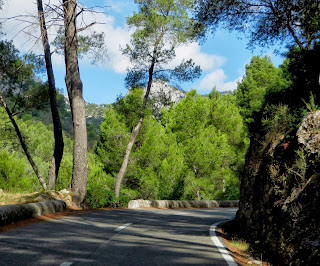




































































































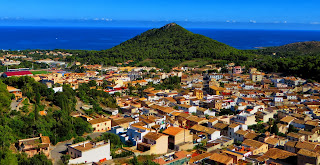
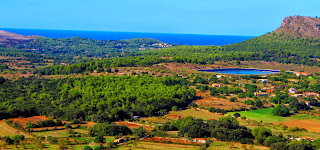




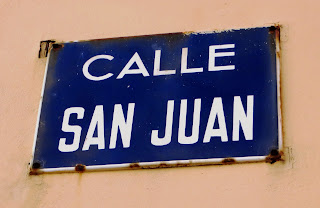
























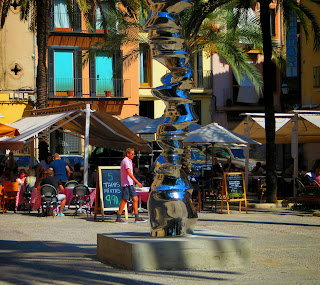





































My sincere compliments to the driver, and, of course, the navigator for guiding a vehicle to these fabulous sights.
ReplyDelete